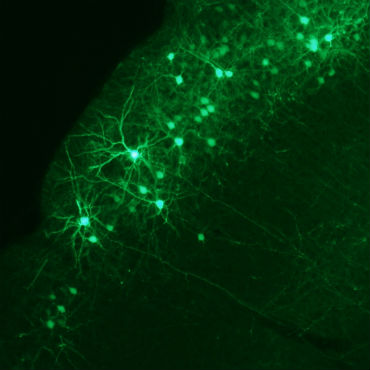Sandia delves into brain-modeled computer systems

Computers based on the neural network of the human brain would be ideal for operating UAVs and solving big-data problems.

Researchers at Sandia National Laboratories are seeking to develop computing systems modeled on neurons in the brain, such as these green fluorescent protein-labeled neurons in a mouse neocortex. Photo by Frances S. Chance, courtesy of Janelia Farm Research Campus.
Researchers are closing in on technology that would supercharge computing capabilities behind big-data analysis and make unmanned vehicles more autonomous, according to an Energy Department research lab.
Industry and government researchers have been working on computer systems that are modeled on the delicate neural network of the human brain rather than traditional computing's parallel processing systems. Sandia National Laboratories researcher Murat Okandan said the brain-modeled systems would be ideal for operating unmanned aerial vehicles (UAVs), robots and remote sensors, and could help solve big-data problems.
Today, those problems and devices need more computational power and better energy efficiency, he told FCW, adding that the developing capabilities could also power continuous diagnostics and mitigation (CDM) technology by sharpening the ability to detect ever-changing intrusion anomalies.
Sandia recently added neuro-inspired computing as a long-term research project in support of future computer system development. Neuro-inspired computing seeks to create algorithms for computers that function more like a brain than a conventional CPU, Okandan said. The new capabilities would operate above the more traditional architecture and oversee how that architecture is used. The technology would consume a minuscule amount of power, which would make the systems more portable and free up room for more computing.
Neuro-based systems could also act more autonomously in a number of roles, Okandan said. In a CDM environment, for instance, a neuro-based system might be able to better detect anomalies without having seen them before or allow a UAV to make its own decisions about where to look and what to look for instead of relying on a remote operator.
Sandia has tapped diverse facilities for its research, including its Microsystems and Engineering Sciences Applications fabrication plant, which can build interconnected computational elements; its computer architecture group with its long history of designing and building supercomputers; and the lab's cognitive neurosciences researchers with expertise in areas such as brain-inspired algorithms.
Okandan said the first breakthroughs in neural-modeled systems are not far off. Although he declined to predict exactly when the capabilities would make their way into the market, he said the initial commercial applications could start appearing in the next five years. More advanced, specialized capabilities developed by government research facilities might take longer, he added.


